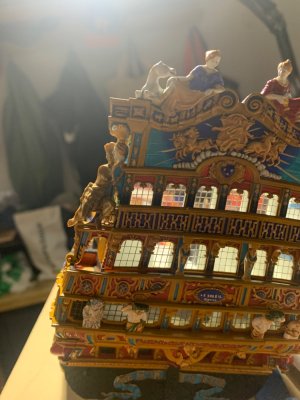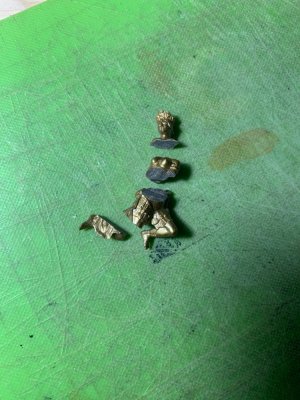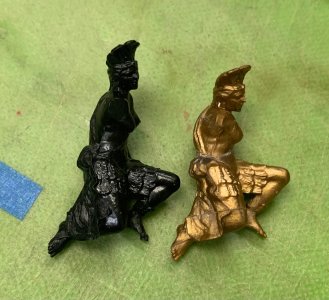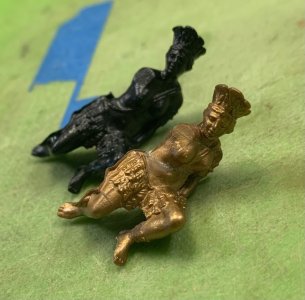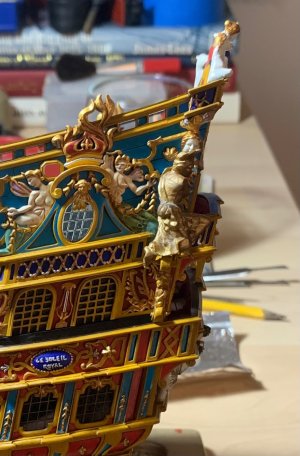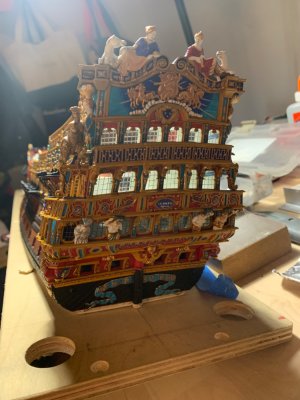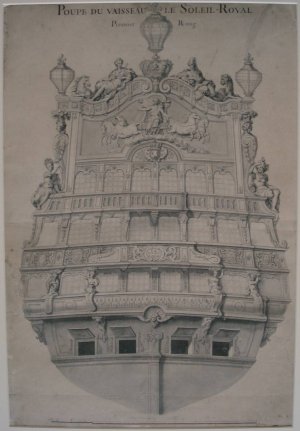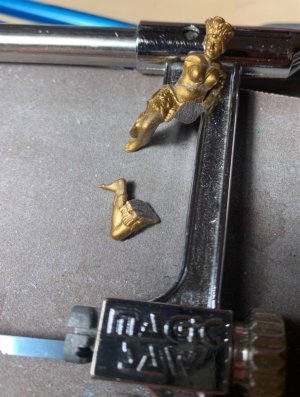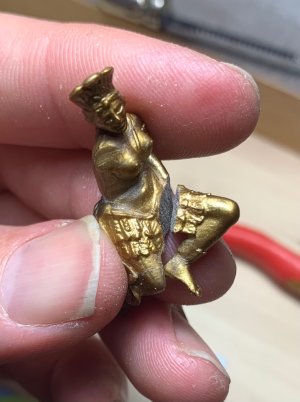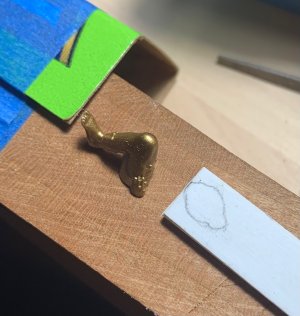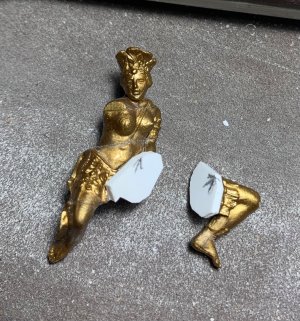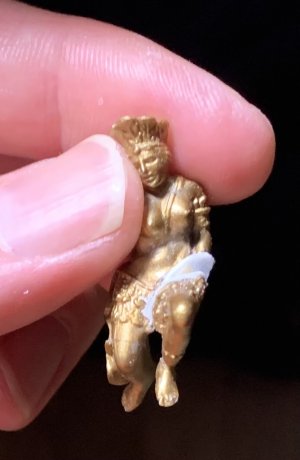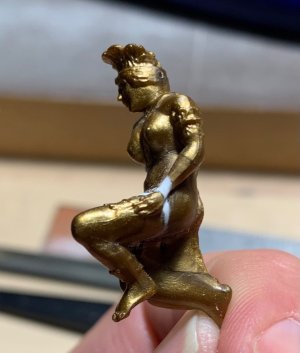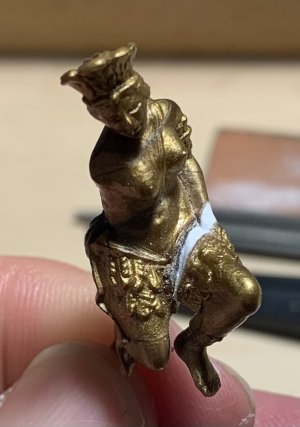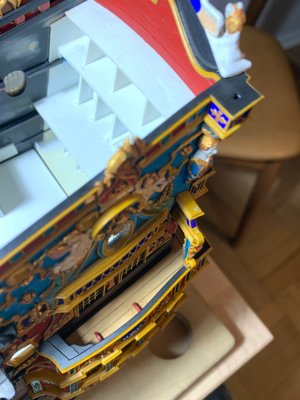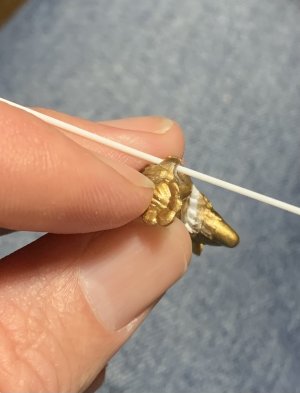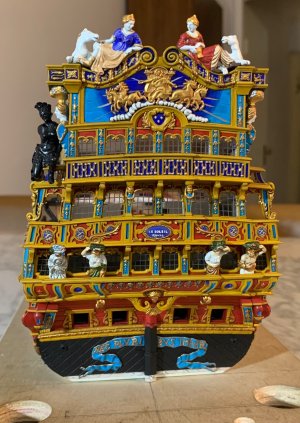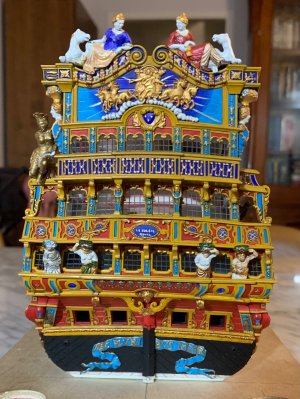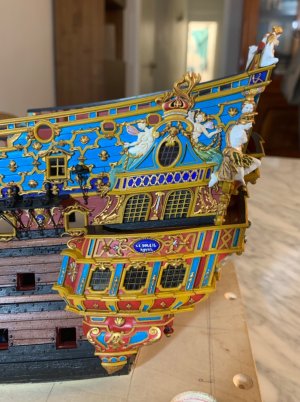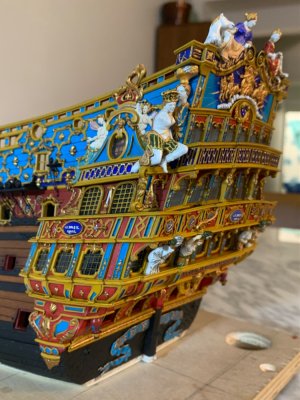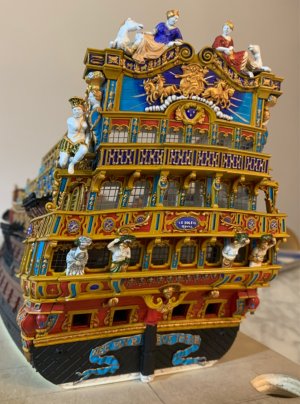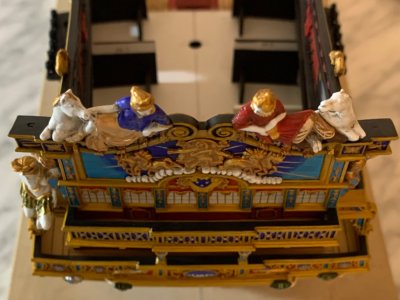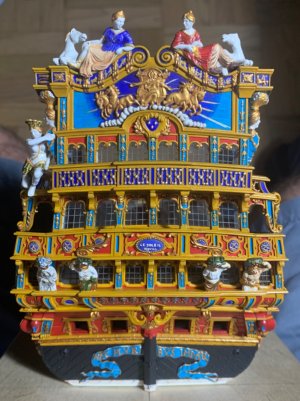After quite a loooong time, I have finally completed the channel and backstay deadeye chains. I still have a little black touch-up to do, but most of that is looking pretty ship-shape. I’m quite relieved to be past that.
My sweet spot on this build has been modifying and manipulating the posture of the large figure carvings. I wanted to get back to doing a little of the work that excites me, and the figures of The Americas and Africa are the final pieces of the ornamental program that I have yet to complete.
I have no choice, but to carve Africa from scratch, as Berain’s drawn figure is in such a radically different posture than the kit’s pose. I’ve roughed-out a blank in cherry, which is quite hard, but will hold fine detail in a small scale. Depending upon the quality of the finished carving, and whether or not I find it necessary to graft the plastic head onto the wooden body, I may simply apply Danish Oil to the carving as a call-out to the modification work that was done to the model.
On the port side, though, for quite a while I’ve been mulling over the potential for adapting The Americas figure. After all, the kit sculpture is far superior to whatever I could muster from scratch.
The main problem is that the stock figure is far too tall to fit within my reduced stern height. As a refresher: at the start of the project, I cut the top sheer-step away (1/4”), but replaced it by half with a low, long sheer cap-railing (1/8” +), and I lowered the side lantern boxes (1/4”), so that their tops were flush with the sheer-railing. This nets out to about 3/8” overall height reduction of the stern. That was how I could ensure that the field backdrop for the tafferal carving of Apollo more closely mirrored that of the Berain drawing. This was my main priority.
The consequence of that choice, if I wanted to recycle the figure carvings, was that I would have to modify them in a way that brought them closer to scale.
When I made the quarter gallery drawing, I drew Africa without regard for the position of the quarter pieces (the bust carvings that support the side lantern boxes). As for those busts, I merely reduced their length from the bottom. I should, perhaps, have decapitated them to shorten their necks, but I hadn’t thought far enough ahead to see how the figure carvings would relate to them.
Here is the fit before modification. She’s practically making out with the quarter piece:
View attachment 467859
My plan was to make a series of narrow-kerf cuts across the outside leg, the lower torso, upper torso and neck.
View attachment 467858
The neck cut followed the re-assembly after the first three cuts because I needed something more substantial to hold onto, while making the neck cut.
This worked far better than expected.
View attachment 467857
View attachment 467856
You can see what amounts to an overall reduction in height of 3/16”. This may not seem like much, but it makes all the difference.
Post-cut fit:
View attachment 467854
Although her crown comes up and slightly obscures the face of the quarter bust, at least her face is now below that of the bust.
View attachment 467855
I didn’t like how the inboard foot is just dangling in the air. A quick check of Berain indicates that the in-board foot should be swept out-board so that the pierced lattice of the archway is visible.
View attachment 467860
Considering how much time and effort went into making those archways, I would very much prefer that the lattice work remain visible.
With that in mind, I decided to section off the inboard leg, through the groin.
View attachment 467853
By positioning the leg the way I want it, I can get a sense of the angles at play, and the void that needs to be filled.
View attachment 467852
With 1/16” styrene fillers glued to each mating surface, I could then begin the process of fettling the joint, until I get that foot to rest where I want it to.
View attachment 467851
View attachment 467850
View attachment 467849
The resulting re-join is highly imperfect seeming, but all of that extra plastic will be carved away and detail added back to provide the visual continuity that is so lacking, at the moment.
After fairing:
View attachment 467847
View attachment 467848
Now, I can fair her seating position along her under-carriage.
There are only three tenuous connection points: the outboard ankle, her seat, and the inboard shoulder with the quarter piece. I decided to add a few steel pins - one to the ankle and one to her seat.
I also want to pin through the inboard shoulder, into the quarter piece. The pin locations drilled:
View attachment 467845
The one for her seat was really tedious to drill because the quarter piece and lantern box prevented me from using a pin vise. I had to trap the top of the micro bit with the fore-fingernail of my off-hand, apply pressure, and turn the bit with my other thumb and fore-finger. This was a real test of patience, and I managed to not break away the archway.
For the shoulder pin, I’m using .035 styrene rod:
View attachment 467846
You can see how I had to flatten the fore face of the shoulder and bicep, so that the figure would nestle-into the quarter piece.
And, so, the un-modified figure before (I have an extra):
View attachment 467843
And After:
View attachment 467844
This figure now is in proportion with Europe and Asia, above, and matches the height of my Africa figure (not pictured).
I will paint the figure and glue her ankle, seat, and shoulder. The shoulder pin has to be inserted after the figure is in-place, which is why I chose styrene for that pin; I can easily trim it, fair it, fill with putty and re-paint after installation.
Thankfully, I realized that the angle of the arm needs to be modified a little, in order to wrap around the quarter piece. I will position the arm after the carving is secured, to ensure exact placement. You can’t, after all, maneuver the two steel pins into place, with the arm on because you need a little wiggle room to get around and up against the quarter piece.
The figure will be grey-washed white like Europe and Asia, and I will probably do Citadel green wash for her skirt, with highlights of bright gold.
I will soon get back to the rigging of the main deck guns. Thank you all for your likes, comments and continued interest.
Best regards,
Marc





